King Open Studio Interview
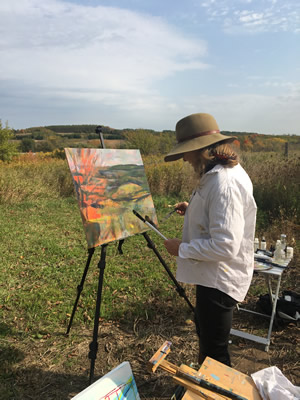
Painting in King. 2020
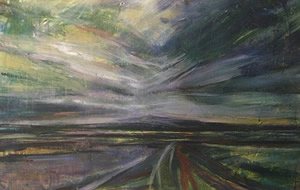
March Winds. Acrylic on panel. 24 x 36″
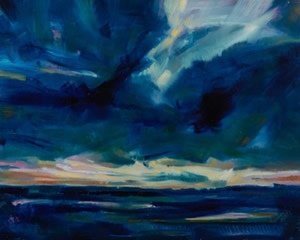
Blue Winds. Oil on canvas. 24 x 36″
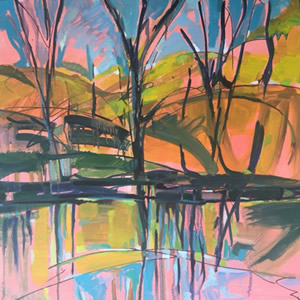
Twenty Valley Trail. Oil on panel. 24 x 24″
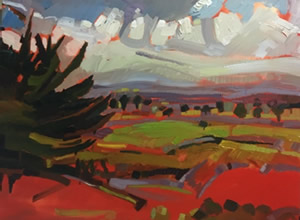
Red Field. Oil on canvas. 16 x 18″
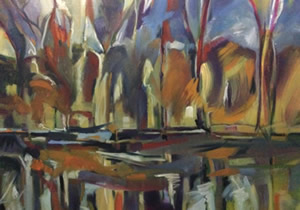
Talking Wood. Oil on panel. 24 x 36
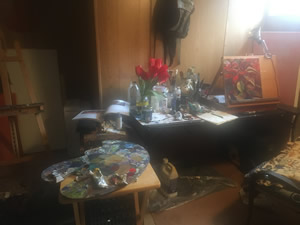
The artist’s studio
LR – What drew you to landscapes?
Nature during the pandemic seems to be more beautiful, finite and alive, similar to a burst of light from a candle before the flame is extinguished. I see paint as a way to express the angst and wildness of the natural world. I honour the balance that nature’s patterns of life and death create.
I learned to love painting by being in Nature. The sound and scent of sea and soil, of rustling trees, the sensations of wind and sun. Nature’s intricacy awes me. The closer I got, the greater my awareness of the complexity of tiny shapes, the intensity of colours. From microbes to whales, every life is connected in a complex and fragile network. In landscape, there are endless discoveries about my relationship with the world. Painting is the way I express my appreciation and love.
LR – Are there central themes?
Landscape to me represents a precarious enormity waiting to be explored. With a holistic perspective, I endeavor to grasp a sense of place across time and space. My work aims to reflect my ethical concern for Mother Earth and my wish to inspire people to visit natural places and be moved to protect the land. A work of art succeeds when it touches the observer as poetry and at times offers solace.
I am an artist/painter following philosophy, not a socio-biologist. When I refer to landscape it is in the context of metaphor. Contemporary, aesthetic movements of form, colour and light represent what I experience, what moves me. I am touched by what I see and what it feels like. The experience involves all my senses as well as my emerging and responsive thoughts.
LR – What do you set out to explore ?
It takes ferocious abandonment to evoke a feeling, to explore varieties of intimacy, avenues of thought and ways of depicting my surroundings. The dark horizon might evoke melancholy, then a shimmer of light suggests a ray of hope. Either way, I long to reach deep inside me and be surprised. This way I make meaning of my world.
LR – Do you start an image with a sketch, photo,
By responding to a combination of sources: a nostalgia of feeling for a certain place perhaps revisited, a sketch, a photo or something I witnessed either in real time or from the internet, news reels, films, ,music, I open up to a variety of options. Usually, I prime my surfaces with a mid-tone to establish the painting’s value scheme and establish the mother base that will continue to link the painting from start to finish. During the Covid Epidemic there is a tendency for me to be less inhibited releasing my energies to achieve a dynamism that is self-propagating.
As a result, I open up by throwing paint on a surface to begin a work.-
If working Plein Air, several canvasses come with me to a spot I love to be worked on ensemble. Later I might continue to work on them in my studio, or not. I always work on more than one surface at once either on the floor, a wall or on an easel. I like to surround myself with my work to keep looking at it outside of my studio and so have it placed around me in my bedroom, my kitchen on the floor, everywhere. This can drive me crazy especially when I wake up in the middle of the night!
LR – How does an image evolve?
Thoughts skim across my brain and then form an awareness and initial marks are made. The painting begins to build its architecture. Forms and colors are considered by comparing one object, one colour or line alongside another. Lately I have used my watercolor method by applying oil paint to a panel with the same free approach. The painting begins to build its architecture. I respond with energetic gestures to further the dialogue by establishing an organic relationship with the composition. The energy may change from quiet to intense and back again in a process that can feel full of anxiety. I am adrift as the paint morphs into a painting as if on its own path.
LR – Why do you choose to work in this process?
I like to challenge my comfort zones and establish an active relationship with my subject. Painting for me is about my inner being. A tree dancing and the reflection in water might personify my inner anxieties, sadness or joys. It becomes metaphysical.
LR – What is your goal in your color usage?
“Color is not an easy matter” asserted Umberto Eco. It demands daring. Potentially uncontrollable, even threatening, colour is very prone to individual interpretation. As the most plastic of all design elements, it is a chameleon like me.
I use a Metameric method which can suggest butterfly effects of changing hues according to light conditions. This can be wonderful or lead to uneasy interpretations.
I also juxtapose large areas of color with small regions of detail in asymmetrical compositions relating macro to micro. Decisions concerning individual colors are made spontaneously. Success is a cohesive image that resonates with the viewer. Meditative or animated, this active process can embody the fantastic and that is I want my landscapes to portray.
LR – What material do you choose to work in?
Watercolor and oil paint on panels, paper and canvas are my main materials, but I delight in expanding into diverse mediums/materials. Using my hands as well as various tools such as sticks, brushes or found objects suggests a craft process. I apply thin glazes to trap the light between the layers, refracting to a jewel-like surface. The atmosphere can be ethereal or misty. The oil mediums dry slowly enough to allow an in-depth exploration of the canvas, while watercolors are fast and hard to control, keeping the paint handling active. A restless wind can hint at the illusive.
Surprises are exciting. An accident becomes an incident. Everything happens in that moment, giving rise to new metaphors.
LR – How do you choose the landscapes you do?
Landscape painting seems more relevant than ever. I may be motivated when I come across ploughed red field in autumn that might suggest a metaphor for our Anthropocene epoch. The impact of the human ecological footprint underscores my need for reflection.
I consider my work to be in the romantic tradition of poetry so when I choose to paint a woodland, “en plein air” I imagine that the trees whisper countless narratives. Such sensory and imaginative immersion leads to a very different painting than a painting I might have produced indoors.